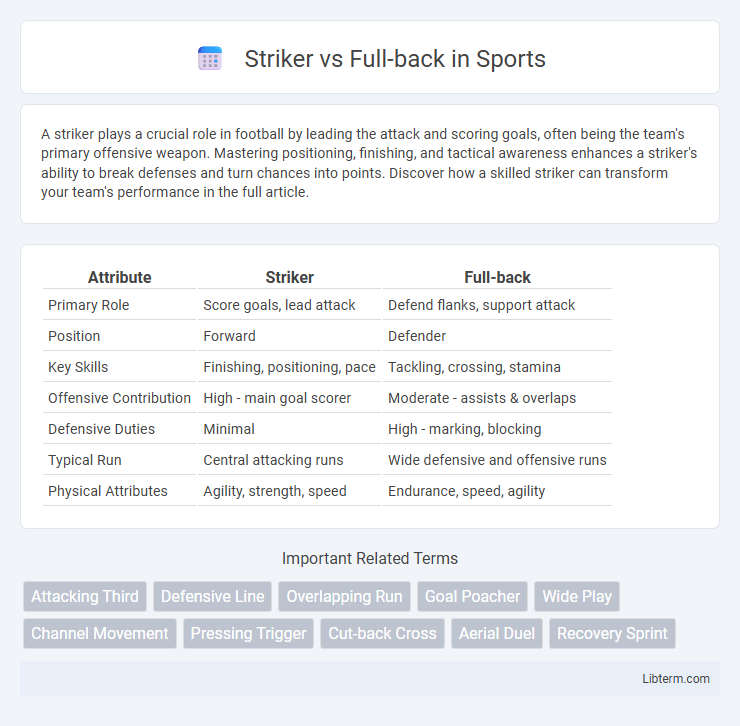A striker plays a crucial role in football by leading the attack and scoring goals, often being the team's primary offensive weapon. Mastering positioning, finishing, and tactical awareness enhances a striker's ability to break defenses and turn chances into points. Discover how a skilled striker can transform your team's performance in the full article.
Table of Comparison
| Attribute | Striker | Full-back |
|---|---|---|
| Primary Role | Score goals, lead attack | Defend flanks, support attack |
| Position | Forward | Defender |
| Key Skills | Finishing, positioning, pace | Tackling, crossing, stamina |
| Offensive Contribution | High - main goal scorer | Moderate - assists & overlaps |
| Defensive Duties | Minimal | High - marking, blocking |
| Typical Run | Central attacking runs | Wide defensive and offensive runs |
| Physical Attributes | Agility, strength, speed | Endurance, speed, agility |
Introduction: Understanding Striker and Full-back Roles
Strikers specialize in scoring goals and leading offensive attacks, often positioned closest to the opponent's goal to capitalize on scoring opportunities. Full-backs primarily defend against opposing wingers and support offensive plays by providing width and overlapping runs along the flanks. Understanding these distinct roles helps analyze team strategies and individual player responsibilities in modern soccer.
Key Responsibilities of a Striker
A striker's key responsibilities include scoring goals, creating scoring opportunities, and applying constant pressure on the opposition's defense. They must demonstrate excellent positioning, clinical finishing, and the ability to exploit defensive gaps. Strikers also assist in initiating counterattacks by holding up the ball and linking play with midfielders and wingers.
Primary Duties of a Full-back
The primary duties of a full-back include defending against opposition wingers, preventing crosses, and supporting the central defenders in maintaining a solid defensive line. They also contribute to offensive plays by overlapping with midfielders, delivering crosses into the box, and providing width to stretch the opponent's defense. Full-backs require stamina, tactical awareness, and strong tackling skills to balance defensive responsibilities with attacking support effectively.
Tactical Positioning: Striker vs Full-back
Strikers position themselves high up the pitch, aiming to exploit defensive gaps and create scoring opportunities through strategic movement against center-backs. Full-backs occupy wider defensive zones, balancing between marking wingers and supporting offensive plays by overlapping or underlapping on the flanks. Tactical positioning for strikers centers on timing runs and spatial awareness in the final third, whereas full-backs prioritize maintaining defensive shape while providing width and delivering crosses.
Skills Required for Top Strikers
Top strikers excel in skills such as clinical finishing, precise positioning, and strong aerial ability to consistently convert scoring chances. Their agility, pace, and ball control enable them to evade defenders and create goal-scoring opportunities under pressure. Mastery of off-the-ball movement and anticipation distinguishes elite strikers from full-backs, who primarily specialize in defensive skills and wide-area play.
Essential Attributes of a Successful Full-back
Successful full-backs demonstrate exceptional pace, stamina, and tactical awareness, enabling them to support both defense and attack effectively. Strong positional sense and precise crossing abilities allow full-backs to deliver accurate balls into the opponent's penalty area, creating scoring opportunities for strikers. Defensive skills such as tackling, marking, and the ability to read the game are crucial for full-backs to neutralize opposing wingers and maintain the team's defensive solidity.
Impact on Team Offense: Striker Contributions
Strikers play a pivotal role in team offense by consistently positioning themselves to exploit defensive gaps and convert scoring opportunities, significantly boosting goal tallies. Their ability to execute clinical finishes and create space often forces opposing defenses to reorganize, allowing midfielders and wingers to advance more freely. High-performing strikers also contribute through key assists and pressing, initiating offensive plays that enhance overall team attacking dynamics.
Defensive Influence: Full-back’s Role in Team Structure
Full-backs play a crucial defensive role by marking wingers, intercepting passes, and blocking crosses, thereby limiting the attacking options of the opposition's striker. Their positioning and ability to track back quickly help maintain the team's defensive shape and prevent counterattacks. Effective full-backs combine defensive discipline with support for midfielders and center-backs, reinforcing the overall team structure against offensive threats.
Famous Strikers and Full-backs in Football History
Famous strikers such as Pele, Cristiano Ronaldo, and Lionel Messi have defined football history with exceptional goal-scoring abilities and creativity in the attacking third. Legendary full-backs like Cafu, Paolo Maldini, and Dani Alves revolutionized defensive roles by combining solid defending with offensive support, often contributing assists and key passes. Comparing these positions highlights the critical balance between offensive prowess and defensive solidity that shapes the success of football teams worldwide.
Choosing Your Position: Striker or Full-back?
Choosing between striker and full-back depends on your preferred playing style and key attributes. Strikers require sharp finishing skills, agility, and the ability to anticipate goal-scoring opportunities, while full-backs demand stamina, defensive awareness, and precision in crossing. Assessing individual strengths in speed, tactical positioning, and teamwork can guide a player to the ideal role, maximizing effectiveness on the pitch.
Striker Infographic

 libterm.com
libterm.com